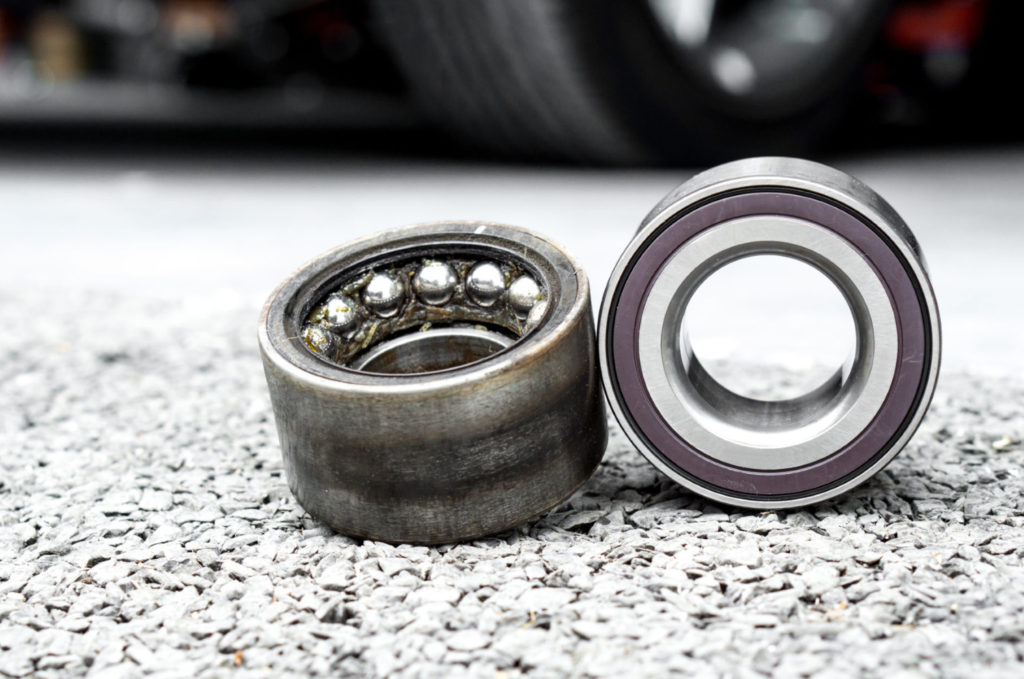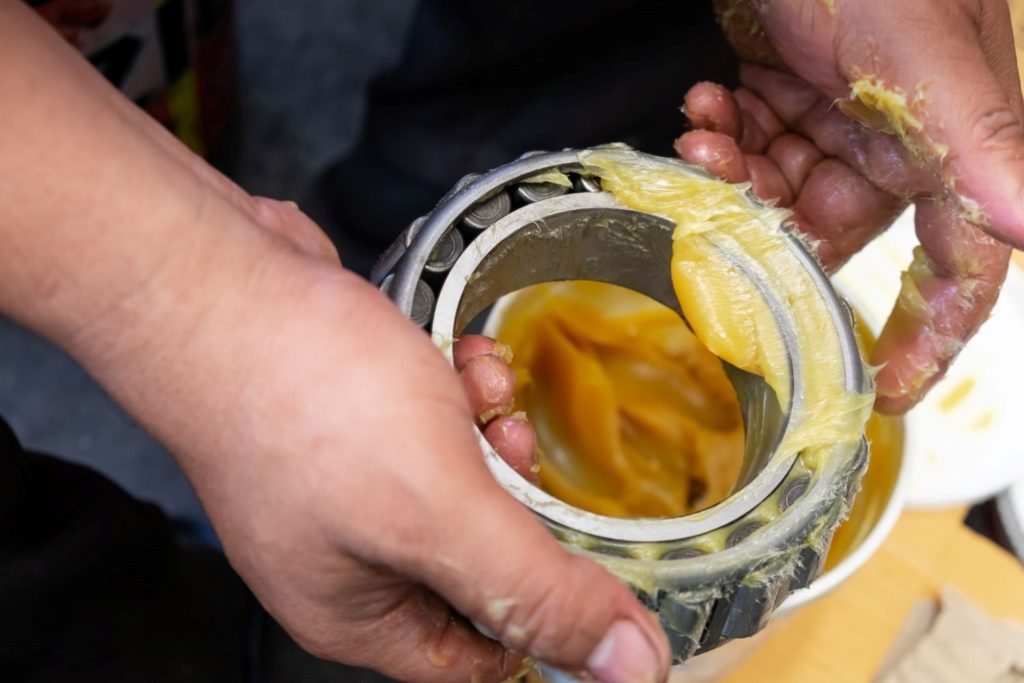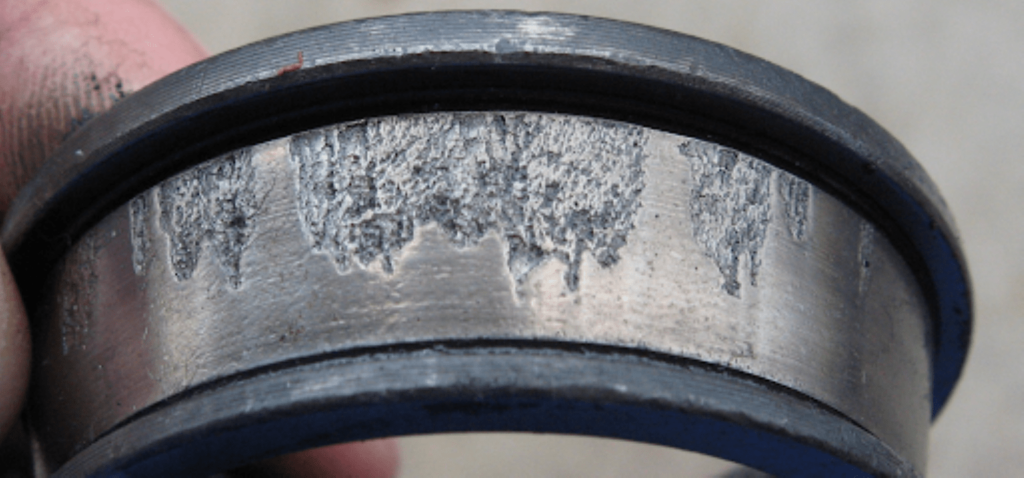Wheel bearings are some of the hardest-working parts of any vehicle. They’re there to ensure that the wheel and tire assembly spins as smoothly as possible, which makes them essential to the handling and safety of your ride.
Manufacturers design bearings to last as long as possible, but the part can go bad earlier than its designated service life. It’s a good idea to find out a wheel bearing’s potential lifespan, so you can plan for its replacement.
How Long Do Wheel Bearings Last?
Standard wheel bearings can last anywhere between 75,000 miles to 150,000 miles. However, some wheel bearings can wear out long before they reach the 75,000-mile mark. Multiple factors may cause premature wear on the part and cause it to fail earlier than designed. Read our mechanic’s note on wheel bearings’ lifespan for more information.

What Factors Can Affect the Service Life of a Wheel Bearing?
Different factors may affect a wheel bearing’s longevity and require its early replacement. Here are some considerations that may help you gauge how long a wheel bearing will last:
Design
The wheel bearing’s design affects its performance, including its lifespan. Original equipment (OE) replacement parts fit and perform exactly the same as the stock wheel bearings in the wheel hubs when the vehicle first rolled out of the factory.
In comparison, performance wheel bearings have higher specifications than stock parts. Made of high-quality materials and featuring the latest technology, these bearings usually last longer than stock or OE replacement parts.

Quality
The quality of the materials used to manufacture the wheel bearing will affect the longevity of the final product. High-end bearings always use the best material available to ensure they can deliver top-notch performance. In contrast, a bearing made from inferior material will wear out faster because its tolerances are lower.
Manufacturer
Not all wheel bearings are made equal—some brands or manufacturers offer certain advantages over others. There are brands that have decades of experience in designing and producing bearings, and they usually have longer-lasting products compared to those produced by other manufacturers.
Installation
While wheel bearings are tough parts, they can still get damaged by careless or harsh handling. For example, if the hub nut is not torqued correctly during installation, the bearing can easily get damaged.
Driving Conditions
A wheel bearing relies on lubricants to minimize the friction between its rolling elements and races. Seals keep the grease inside the bearing while simultaneously keeping contaminants out of the part.
Driving through deep mud or water can compromise the seals and let contaminants seep into the wheel bearing. Water will break down lubricants and can eventually corrode steel. Meanwhile, particulate matter can scratch the smooth surfaces of the bearing’s internal parts.
Loss of lubrication, corrosion, and physical damage may reduce the wheel bearing’s effectiveness because of increased friction and hotter temperatures during operation.
Car Modifications
Many drivers add a personal touch to their ride by replacing stock parts and accessories with components that alter the look or upgrade their vehicle’s performance. Popular modifications include installing larger or heavier rims, tires with lower thread walls, or a stiffer suspension system.
These modifications put extra load on the wheel bearing by altering the vehicle’s characteristics. If the bearing cannot handle the higher load, it may wear out faster.

How to Make Your Wheel Bearings Last Longer
There are certain practices that will help extend the lifespan of your wheel bearings and preserve their performance as they put on the miles and years.
Here are some tips on how to get the most out of your wheel bearings:
Drive Carefully
The harder the wheel bearing works, the faster it wears out. You can reduce the bearing’s workload by driving carefully. Avoid rough maneuvers like abrupt acceleration and sharp turns, which can put a lot of physical stress on the wheel bearings.
Similarly, try to avoid driving on uneven road surfaces.
Avoid Deep Water or Mud
Most wheel bearings can handle getting splashed by water or mud. However, steer clear of deep puddles of water or mud patches that can sink the wheels up to the hub. Dunking the wheel hubs makes it more likely for contaminants to get inside the bearings.
Replace Wheel Bearings In Pairs
If you’re replacing an old or broken wheel bearing, it’s a good idea to change the bearing on the opposite side of the vehicle. If both bearings were installed at the same time, they would have gone through the same conditions and usage.
Ensure the Quality of Replacement Wheel Bearings
It’s possible to get a high-quality wheel bearing replacement without going over your budget. It helps to research different brands and read customer reviews about the quality of their wheel bearings.
Like most auto parts, wheel bearings usually come with a product warranty. A brand that offers some type of guarantee shows the manufacturer’s confidence in its product.
Install New Wheel Bearings Correctly
Unless you have extensive experience in DIY car repair and maintenance, bring your vehicle to an auto shop and have a professional mechanic install your new wheel bearings.
If you plan on replacing the wheel bearings yourself, be sure to follow the manufacturer’s recommended installation procedure.
It may be tempting to reuse old bolts and seals on new bearings to save a few bucks. However, these old parts are just as tired as the bearing they came with. Always use new bearing accessories to ensure the best performance from your replacement parts.
Use Manufacturer-Recommended Parts
Different makes and models are fitted with wheel bearings of different specifications. Be sure to check for vehicle compatibility to get the correct wheel bearings for your application.
Use our website’s filter bar to find the right accessories and replacement parts for your vehicle. Simply enter your vehicle’s year, make, and model in the search field to bring up compatible wheel bearings for your vehicle.
Install Wheel Bearings Suitable For Vehicle Modifications
If you’re set on modifying your vehicle, it’s a good idea to replace the stock wheel bearings. Installing stronger performance bearings can help handle the increased load and stress from custom parts.
A Note on Wheel Bearings’ Lifespan by Richard McCuistian, ASE Certified Master Automobile Technician
A bearing “bears” a load, thus its name. Bearings will have rollers, balls, or needles, depending on the design, and some bearings last longer than others. The variability of the part itself along with outside factors can determine the life of any bearing.
Bearings are sealed to prevent the ingress of moisture and dirt, but sometimes the metal itself will flake off and cause brinelling. On the other hand, some bearings will begin to make noise simply because the grease in the bearing begins to fail, although that’s not terribly common.

Electrical issues can cause bearing failure as well, depending on the configuration of the components involved. One Mazda RX7 kept destroying wheel bearings because of a bad battery-to-block engine ground connection. The current was traveling to the rear axle and arcing at the bearing before returning to the powertrain through the park brake cables. That one stumped everybody and was discovered by accident when the vehicle was bought back and sent to the training center.
The point is that there are more than a few factors that can affect bearing life. One 2003 Explorer with an aluminum differential feeding CV axles to the wheel hubs developed bad differential. Bearings were lubricated with gear oil and the hub bearings were sealed grease bearings.
Where to Get Quality Replacement Wheel Bearings
While you’re able to extend the life of your wheel bearings, there is a limit. You’ll inevitably need to replace your wheel bearings at some point. Damaged wheel bearings can cause your brake rotor to wobble, which can lead to damaged brakes. It’s best to replace your wheel bearings as needed to prevent any of this from happening. The great news is that you can buy replacement wheel bearings easily at CarParts.com.
The CarParts.com catalog has a wide array of wheel bearings from different aftermarket brands. Use our built-in vehicle selector and enter your vehicle’s year, make, and model to see only parts that are guaranteed to fit. Whether high-end or budget-friendly, our parts come with a 60-day return policy and a lifetime replacement guarantee so you can order with confidence.
Don’t wait for your wheel bearings to give out completely before replacing them. Buy a new set of wheel bearings at CarParts.com today.
Any information provided on this Website is for informational purposes only and is not intended to replace consultation with a professional mechanic. The accuracy and timeliness of the information may change from the time of publication.






























